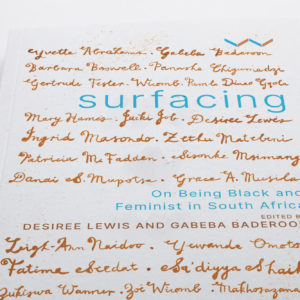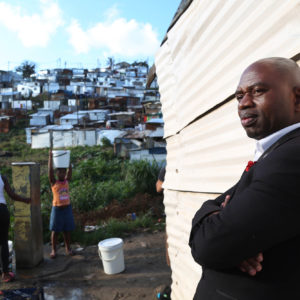Sharp Read | SA’s revolutionary people’s culture
In tracing the legacies of South Africa’s struggle artists, Lebogang Lance Nawa’s weighty anthology offers a glimpse into the lived experience of cultural creators.
Author:
24 September 2021

September is heritage month in South Africa. But it was heralded in late August by the closure of the Liliesleaf Farm museum and the shutdown of the South African Book Development Council.
Liliesleaf was the place where leading ANC militants, including Nelson Mandela, planned their activism, and where security forces arrested them after a Central Intelligence Agency (CIA) tip off. The South African Book Development Council was the representative body of the nation’s book sector, responsible for reading campaigns such as Nal’ibali, the promotion of indigenous literature and events such as the National Book Week and the SA Book Fair.
Meanwhile, the Office of the President has still not responded to a memorandum from the theatre and dance sector demanding urgent action over relief mismanagement and the collapse of incomes and institutions. The sector plans a strike on 29 September. Irony does not begin to describe it all.
So the appearance of Lebogang Lance Nawa’s 600-page anthology, Culture and Liberation Struggle in South Africa: From Colonialism to Postapartheid (Ssali Publishing House, 2021), is timely. It promises insight into how we went from a vibrant, polyphonic liberation culture to a neglected arts sector whose only appearance in the ruling party’s 2019 election manifesto was as “creative industries”, subsumed under the economy section.
Related article:
The book contains analytical essays, research, personal memoir, criticism and visual materials, including both graphics and photo essays. It is divided into six sections, some chronological, others focusing on a topic such as policy or media. As well as chapters that might be expected in a book of this type – on the impact of specific productions such as the musical King Kong and the literary magazine Staffrider, international solidarity, organisations such as Dashiki and the Medu Arts Ensemble – Nawa and his team of five consulting editors and two-dozen-plus chapter writers have uncovered some remarkable narratives of people’s culture never before told.
Lucas Styles Ledwaba, for example, describes Diturupa, the Makapanstad Christmas festivals that, since 1918, have kept alive the memories and pride of former Black soldiers, and nurtured new generations of “troop” artists. Nawa discusses the short fiction of the early progressive newspaper The Guardian. Suzan Skhosana traces another of South Africa’s jazz dynasties, not the better-known Schilders or Ngcukanas, but the Kgasis. (Trumpeter Levy Kgasi played in the African Jazz Pioneers; the family musical tradition long preceded him and continues today.) Advocate and former fashion editor Nakedi Ribane describes how Black beauty pageant contestants devised their own challenges to whiteness.
Uniting theory and practice
One important achievement of Culture and Liberation Struggle in South Africa is to unite theory and practice through narratives like this. The book weaves the lived experience of cultural struggle together with the theory that both informs and is developed through it. Too often in such historical surveys, ideas are documented apart from the lives that grow them, so that a phrase such as “peoples’ culture” feels like a theorist’s label applied from the outside. These grounded stories of creators’ lives and communities convey agency and underline how deliberately political – in asserting dignity, demands and identity – was the art of these and many more working people. Even the choral community – sometimes perceived by outsiders as tending towards staid conservatism – could produce songs such as Benjamin Myataza’s Itilonko Yase Modderbee, an indignant lament for the mistreatment of young Black prisoners by white prison guards and the regime they served.
That such art spoke from authentic experience is particularly important given another prevalent deformation in many academic studies of South African peoples’ culture: the assumption that socialist and communist cultural tropes were imported and inserted into movements from the outside, largely by activists from a different (European-descended, middle-class) background. Such works, it is sometimes further asserted, had no claim to aesthetic value because they were merely “propaganda”.
Related article:
Sometimes such critiques stretch their diagnosis of “Stalinist influence” to extreme, almost comical, lengths. Stalin is often portrayed as a pipe smoker, so, in one example, all similar South African Communist Party images of the 1940s, whoever they depicted, are categorised as under “the influence of images of Stalin smoking”. Pipe smoking, of course, was fashionable among men of all races in the 1940s, and traditional in many African communities. This is not mentioned.
Poet laureate Keorapetse Kgositsile wrote cutting satire of the kind of red-baiting cultural analysis in which some “itchy-fingered thug … dictated … to the poet”. Kgositsile knew that South African working people in the countryside and cities had historically resisted oppression whenever they experienced it and articulated that resistance in both art – what was the so-called “praise singer” if not also a social critic? – and action. Through this resistance, South Africans forged links with pan-African and international movements for freedom. Cultural tropes from elsewhere were adopted when they felt useful, and creatively transformed to reflect South African realities, shaping distinctive aesthetics in the process. It was a circulation of progressive ideas with important South African ingredients, not an imposition from outside.
Homegrown ideas
A key strength of the book is how it conveys this, assembling evidence via both life stories and analysis. Obakeng Kwasi, who meticulously traces how theatrical aesthetics in struggle theatre were shaped, quotes the playwright Matsemela Manaka: “When I started writing and telling stories people would say I was Brechtian. I [used] to take offence because when I wrote I had never heard of [Bertolt] Brecht. I didn’t know about [Jerzy] Grotowski. It was because of the poor conditions in which we lived that led us to create theatre like what Grotowski was doing. In fact, we never knew about Brecht. You know, it just happened. It was the way we told our stories.”
Journalist Sam Mathe demonstrates how, across Africa, the English used in anticolonial literature and drama did not signify deference to language hegemony. Rather, the appropriations and transformations of English by African writers were deliberate gestures of defiance. He quotes playwright Mothobi Mutloatse on the need to “donder [beat up] conventional literature” to this end. Nape ’a Motana outlines the distinctive contributions of Black Consciousness performers in both content and patterns of collective practice.
Giving adequate space to the pioneering role of Black Consciousness in shaping liberation culture is long overdue. In a detailed memoir of growing up in Mamelodi, where Africanist cultural groups were active, the songwriter and musician Vusi Mahlasela describes how, aged 11, a church hall performance profoundly influenced him: “On the pulpit stood a guy reading from a paper and two others on the side thumping drums. I asked what they were doing and [an older friend] said they were rendering poetry. ‘What is poetry?’ I asked … The other two accompanied the recital of the poem with music. I liked that.”
Related article:
Mahlasela’s description sounds very much like contemporary accounts of the performances of the Allah Poets, whose members included Maishe Maponya and Ingoapele Madingoane, but it could also have been Dashiki, whose members are mentioned elsewhere in his narrative, intersecting with the memories of ’a Motana.
The volume also details the historical contribution of the ANC, particularly in three chapters by co-editor and current poet laureate Mongane Wally Serote. Serote discusses international solidarity, Medu, and the immediate post-liberation cultural era, foregrounding the party through the observations of a distinguished writer who has lived long in its ranks. Again there is an intersection with the experience of Mahlasela, who recalls, “Whether or not officially sanctioned, we were convinced that we were involved in underground ANC activities.”
Those are not the only potential points of contact between information in different chapters – photographer Ernest Cole, for example, pops up in several places – and they highlight what is probably the book’s main structural flaw in terms of usefulness: there is no index, even a simple list of proper names. Many of these stories have never been heard before, researchers – formal and informal – want to be able to bring them together, set them side by side, or simply track how one figure appears and reappears in different contexts. An index is a vital tool for such work and its lack is keenly felt.
Nevertheless, the tapestry the book weaves of the interconnections of people, ideas and activities creates for a reader a rich and distinctive panorama of South Africa’s revolutionary people’s culture. The same reader is then pulled up sharply by the question of how that heritage could have withered so dramatically – not on streets and stages and in demonstrations, where many cultural creators still challenge an unjust status quo, but in public policy, often formulated at the behest of people who lived through those days.
Art and government policy
Shortfalls and missteps in policy have revived the awareness, strong during the struggle era, that what happens in and to the arts matters for many more than a few elite practitioners. Those flames were fanned recently by widespread anger over the National Arts Council’s flawed disbursement of Presidential Employment Stimulus Programme funds to artists and the defensive response of the national ministry. But not all commentators look towards the same kinds of solutions.
Nawa’s book appears six months after another collection of essays on similar themes: the Mapungubwe Institute’s Mintirho ya Vulavula: Arts, National Identities and Democracy. The volume “examines the role of arts and culture in consolidating our nascent democracy and in transforming society”. Its recommendations echo the instrumentalist perspective of its blurb and while some, such as bridging the digital divide, are useful, overall they break little new ground. There is a centralising focus on “establishing institutions”, while the government is urged to “support artists to produce work that contributes to resolving everyday socioeconomic challenges in South Africa”.
Related article:
In the context of such a dystopian prospect, where state bureaucrats determine which work “contributes to resolving … challenges” and should therefore be supported (and what happens to the rest?), Nawa’s volume by contrast poses – indirectly through accounts of experience and directly in analysis – far more challenging questions about mission and direction. But given the historical span and conceptual breadth of Culture and Liberation Struggle in South Africa, it cannot do much more than signal urgently that extensive further work and debate are required.
Policy considerations are implicit in many of the chapters throughout, and the final third of the book is explicitly devoted to them. Its contents are diverse and interesting. They include Nawa’s question and answer session with Mike van Graan, laying out the progress – one step forward two steps back – of national policy-making, as well as perceptive analysis from Akhona Ndzuta of how arts organisations have had to return to “[preparedness] to revolt” to fight for agency. Interweaving praxis and commentary, these sit alongside personal memoir, analysis and criticism of contemporary productions.
Commodifying culture
It is disappointing, though, that the problematic persistence of the “creative industries” discourse does not receive more consideration. Internationally, that discourse is slowly beginning to slide out of fashion under a barrage of academic and practitioner criticism. But that is no reason to forget it. In South Africa it continues to sound very loud, as the 2019 ANC manifesto and prevailing policies, such as the Mzansi Golden Economy, illustrate. The Mzansi Golden Economy, for example, describes itself as “a strategy to reposition the cultural industries in South Africa. The strategy opens up the arts, culture and heritage sector to contribute to economic growth and job creation comprehensively.”
Van Graan traces the genesis of creative industries thinking in South Africa to the 2005 Cultural Industries Growth Strategy, which he calls “a misguided attempt to show other government departments that the arts should be taken seriously because of their contribution to [gross domestic product], job creation and earning foreign currency”.
Limiting the analysis to that local origin, however, disconnects those debates in South Africa from their historical roots in global struggles for hegemony. Internationally, the commodification of culture, signalled by a terminological shift in policy documents from “cultural activities” to “cultural goods”, emerged from tensions in the late 1990s and early 2000s that international agencies such as Unesco were eager to bridge or mask. A neoliberal United States was reluctant to support international culture and development policies advocated by the nations of the Global South that did not put profit and the marketplace front and centre.
Related article:
The lexical fudge, to keep America on board, was to reword cultural discourse around the “dual value” of the arts: cultural and economic. Global North and South could embrace those aspects of policy that spoke to their respective concerns and, conveniently, the terminology also papered over disputed definitions such as art/craft and performance/celebration by employing portmanteau categories that conflated them.
The result, though, was not a compromise from which both sides benefitted, but a victory for American economic neoliberalism in international cultural policy. The meaning of culture was reframed exclusively in terms of marketable products, private ownership, business profit and viability, and the rules of the globalised culture market.
Thus, the 2019 ANC manifesto talks not of opening the doors of culture and learning (as the Freedom Charter did) but of implementing “cultural projects in schools and communities that raise awareness of career opportunities in the creative industries” and ensuring “demand for creative goods and services by tourists by supporting the development of creative industries”. The liberatory possibilities of all South Africans freely accessing creative activities, as both makers and appreciators, have disappeared. Instead, some South Africans may end up labouring in culture to serve foreign tourists. That this is still policy should surely be discussed in a book such as this?
But it would be unfair to expect Culture and Liberation Struggle in South Africa to cover every aspect of every issue: its title defines its mission clearly; the contents fulfil that mission comprehensively. The book occupies a niche that has remained empty and dusty for far too long – reading it sometimes feels like discovering a massive, 21st-century volume of Staffrider, and that’s a joyful experience. But it can’t remain the only text. We need more words and work like this from – as Mahlasela describes himself – the “[doctors] who ought to diagnose humanity’s existential problems and offer solutions”.





